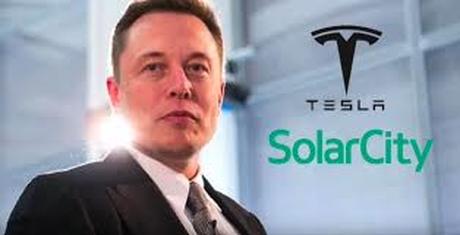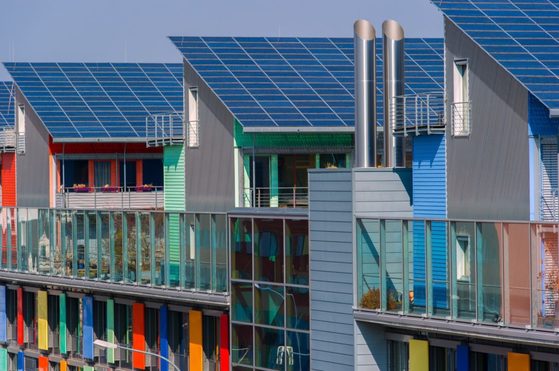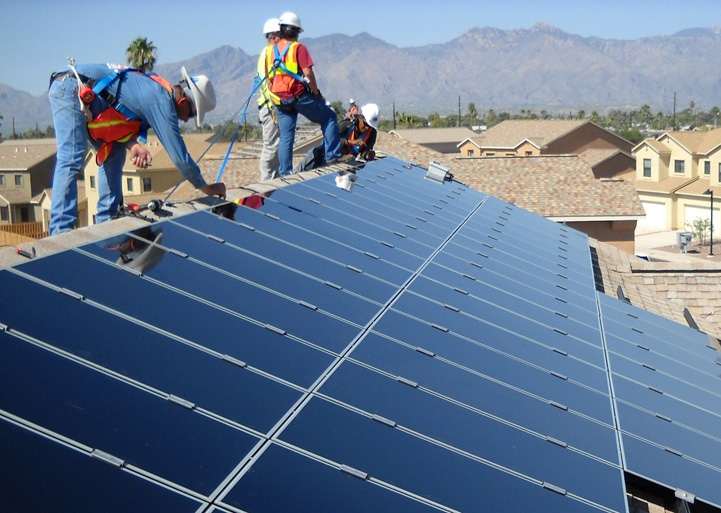|
On Monday the St. Petersburg City Council unanimously approved the city's commitment to transition to 100% clean energy. Over 300,000 customers have saved over $172,000,000 and growing on their electric bills. Find out how you can go solar for $0 down with America’s #1 solar provider. SEE IF YOU QUALIFY ECOWATCH — St. Petersburg represents the first city in Florida and the 20th in the country to make such a commitment. In a unanimous vote, the City Council Committee of the Whole allocated $250K of BP Oil Spill settlement funds to an "Integrated Sustainability Action Plan," which will chart a roadmap to 100% renewable energy. In addition, the plan also incorporates components of a climate action plan, a resiliency plan, and strategies for St. Petersburg to achieve a 5 STAR Community rating. The 100% clean energy roadmap builds on Mayor Rick Kriseman's executive order establishing a net-zero energy goal for the city earlier in 2016. "The movement for clean energy in cities and towns across the country is now more important than ever," Sierra Club Executive Director Michael Brune said. "Whether you're from a red state or a blue state, clean energy works for everyone and local leaders will continue to move forward to create more jobs, stronger communities, and cleaner air and water." "This is a historic moment for St. Pete," Emily Gorman, campaign manager for Suncoast Sierra Club's Ready for 100% St. Pete, said. "We envision a city where families can raise their kids in communities free from toxic pollution, where everyone has the opportunity for a good job and access to healthy, affordable energy. The transition to 100 percent clean, renewable energy will ensure a more resilient, sustainable and equitable future for all our residents." On a related note, President-elect Donald Trump, who has expressed doubts about climate change being real, appeared to soften his stance in a meeting with reporters from the New York Times Tuesday, conceding there was "some connectivity" between humans and the issue. The idea of climate change caused by human activity is something that is accepted by nearly the entire scientific community. Trump also told the Times Tuesday he had an open mind about an international climate agreement approved by world leaders last year in Paris that was aimed at mandating energy shifts worldwide to help combat climate change. That's a significant shift from a man who once claimed climate change was a hoax perpetrated by the Chinese government. Thank you to our friends at EcoWatch for providing the original article below. Source: http://www.ecowatch.com/saint-petersburg-florida-renewable-energy-2105155924.html
0 Comments
Tesla’s acquisition of SolarCity officially closed Monday morning, bringing together Elon Musk’s electric vehicle company with the solar energy company founded by his cousins Lyndon and Peter Rive. The deal was approved by Tesla and SolarCity shareholders last week, after first being proposed earlier this year.
Tesla provided the following brief statement on the news: We’re pleased to announce that Tesla’s acquisition of SolarCity closed this morning. Succinct, and probably an understatement – Musk has been advocating for the union of the two companies vocally and frequently since proposing the idea in June. Joining the two entities is central to the continued execution of his “Master Plan,” which aims to provide customers with full-stack solutions for owning their own energy production, storage and consumption. Tesla’s recent solar roof tile launch showed why Musk believes the companies are a natural fit under a unified Tesla roof (I woke up very early, please allow me this joke). To Musk, there is not a demarcation point beyond clean generation of electric power and vehicles that make use of said power for emission-free operation. It makes sense, because the cleanliness and cost of the source is just as important as the cleanliness of operation when it comes to overall carbon footprint contribution. Last month Environment America Research & Policy Center released a new review of 16 value-of-solar studies from around the country. HELP TECHNOLOGY — The report found that there are at least 8 key benefits of rooftop solar: 1. Reduced waste Solar energy systems produce clean, renewable electricity on-site, reducing the amount of power utilities must generate or purchase from fossil fuel-fired power plants. In addition, distributed solar-systems reduce the amount of energy lost in generation, long-distance transmission, and distribution, which cost Americans about $21 billion in 2014. 2. Lower costs By reducing overall demand for electricity during daytime hours, solar energy production helps customers and utilities avoid investments in new power plants. Also, by reducing demand for energy from the grid, home and business solar systems reduce the overall price of electricity, saving money for all customers. 3. Less risk Because the price of solar energy tends to be stable over time, whereas the price of fossil fuels can fluctuate sharply, integrating more solar energy into the grid reduces consumers’ exposure to volatile electricity prices. 4. Stronger grid Distributed energy decentralizes the grid, potentially safeguarding people in one region from other areas that are experiencing problems, like blackouts. Emerging technologies, including smart meters and battery storage systems, will enhance this value. 5. Clean electricity Increasing solar energy capacity helps utilities avoid the costs of meeting renewable energy requirements or installing new technologies to clean-up fossil fuel-fired power plants. It also helps avoid the cost of emission allowances where pollution is capped, like in California and New York. 6. Reduced greenhouse gases In 2014, the electricity sector was the largest source of carbon emissions, responsible for 30% of all U.S. greenhouse gas pollution. Generating energy from the sun provides a renewable source of energy that produces no greenhouse gas emissions. In 2015, distributed solar energy alone—just solar panels on households and businesses, averted approximately 8 million metric tons of carbon dioxide emissions. 7. Improved public health Solar can help us reduce health costs. According to the American Lung Association, 52% of Americans live in a place where pollution often reaches dangerous levels. As described in a recent blogpost, a National Research Council study found that health-impacting pollutants from coal- and gas-fired power plants, respectively, cost society 3.2 cents and 0.16 cents per unit of generated electricity (kilowatt-hour). With an average household in the United States using about 11,000 kilowatt-hours of electricity each year, the health cost associated with that electricity consumption would be about $350/year if it all came from a coal plant. 8. Economic growth The American solar industry is growing rapidly, creating new jobs and businesses across the nation. In 2015, the solar industry added jobs at a rate 12 times that of the overall economy, and as of November 2015, employed more than 208,000 people. The report also shows that solar panels on homes, schools, and businesses often provide more benefits than they receive through programs like net metering, which credits solar panel owners when they generate more power than they use, providing electricity for other customers. Thank you to our friends at HELP Technology for providing the original article below. Source: http://www.ledpv.com/blog/8-key-benefits-of-rooftop-solar-found-in-solar-value-studies_b117 Burlington's decades-long commitment to sustainability has paid off with cheap electricity—and some pretty great homegrown food. The city is the first in the nation to obtain all of its power from renewable sources. Colin Woodard, POLITICO — To understand what makes Burlington unlike almost any other city in America when it comes to the power it consumes, it helps to look inside the train that rolls into town every day. The 24 freight cars that pull up to the city’s power plant aren’t packed with Appalachian coal or Canadian fuel, but wood. Each day 1,800 tons of pine and timber slash, sustainably harvested within a 60-mile radius, is fed into the roaring furnaces of the McNeil Generating Station, pumping out nearly half of the city’s electricity needs. Much of the rest of what Burlington’s 42,000 citizens need to keep the lights on comes from a combination of hydroelectric power drawn from a plant it built a half mile up the Winooski River, four wind turbines on nearby Georgia Mountain, and a massive array of solar panels at the airport. Together these sources helped secure Burlington the distinction of being the country’s first city that draws 100 percent of its power from renewable sources. The net energy costs are cheap enough that the city has not had to raise electric rates for its customers in eight years. And Burlington is not done in its quest for energy conservation. Add in the city’s plan for an expansive bike path, a growing network of electric vehicle charging stations and an ambitious plan to pipe the McNeil station’s waste heat to warm downtown buildings, and City Hall’s goal to be a net zero consumer of energy within 10 years starts looking achievable. How did this former logging port transform itself to a global trendsetter in sustainable development and green power? The answer carries particular resonance at a time when the United States’ commitment to environmental issues and addressing climate change is suddenly less certain than at any time in a decade. Cities like Burlington, the largest city in a state whose tourism and agriculture dependent economy is vulnerable to climate change, have had to craft their own solutions to address global warming and to insulate themselves from the volatility of global energy markets. Indeed, because Burlington owns its own utility with its own citywide grid, the city could theoretically close its three connections with the wider world and generate all of its power from McNeil, Winooski One, wind turbines, and solar panels. This led a visiting writer for Orion magazine to declare this was where she would move to wait out a zombie apocalypse. Achieving “Net Zero” A city is considered net zero when it generates as much energy as it consumes, not just in the form of electricity, but heat and transportation as well. Achieving such a state would even further insulate Burlington from the volatility of fossil fuel markets, saving money and luring more entrepreneurs and businesses linked to sustainability, such as Ben & Jerry’s ice cream, green cleaning products maker Seventh Generation, and climate-conscious Burton Snowboards. “We’ve got our own goals around eliminating our carbon footprint completely, and being based in a city where that’s easily possible is very important to us,” says Joey Bergstein of Seventh Generation. “Our history here is very much driven by the fact that the city and the state of Vermont are so aligned with our values.” At the city-owned airport, they’ve reduced demand for heat and electricity by replacing lighting and air conditioning systems and properly insulating the terminal’s roof. There’s a 500-kilowatt solar array that’s been providing enough power to supply 60 homes and a rain garden on the roof of the parking garage. “We’re a small airport and we don’t have a lot of money, but what we try to do is to introduce a greener way whenever we change a bulb, replace a window, or repair our roof in a way that gives us a greater energy savings and return on our investment over time,” says city aviation director Gene Richards, who cut electricity usage at the airport by a fifth in three years. Achieving net zero in transportation is thornier than heating and power because there are few big users to focus on and only a handful of users have invested in all-electric vehicles. “There’s the range anxiety with electric vehicles—can I go far enough?—so having enough well-placed charging stations is really helpful,” says Lunderville of Burlington Electric, which has deployed 10 multiple-outlet charging stations at strategic locations around the city, and plans to add five to six annually. Decentralizing Electricity Generation: Giving the Power Back to the People, Literally Burlington Electric is preparing for a challenge of its own: Its grid is expected to shift from a “hub-and-spoke” system of power plants and consumers to a distributed network with thousands of tiny producers and storage sites. “The changes are being driven by the customers, who didn’t used to have the option to do their own solar panels or start storing their energy with a Tesla battery pack,” says Lunderville. He envisions creating a system by which the utility could pay customers to store energy for the network at times when they don’t need it banked themselves. The industry expects these changes everywhere, but Burlington is likely to see them early—because of its green ethos and because Vermont offers a variety of incentives for customers to invest in solar. But it’s also the perfect sandbox—a small city that owns its own grid, power generation and public fiber-optic data network— and the utility is ready to pioneer the development of the technology and policies to make it all work. “Having the fiber optics in place is really critical to moving toward this bi-directional energy grid,” says energy consultant Gabrielle Stebbins, who previously headed the state’s renewable energy industry association. “We’re a small state and city, so we’re not driving the bus. But the little motor car we’re driving can tell which roads are possible and feasible.” Thank you to author Colin Woodard and our friends at Politico for providing the original article below. Source: http://www.politico.com/magazine/story/2016/11/burlington-what-works-green-energy-214463
More than 7,500 people have signed a Change.org petition to have Silicon Valley titan Elon Musk diplomatically knock some science into President-elect Donald Trump.
It’s unclear whether such a meeting would have any bearing on Trump’s policy going forward. But still, the idea of having Musk explain climate change and renewable energy to the president-elect is intriguing because it maybe doesn’t seem entirely improbable. Trump’s stated his penchant for surrounding himself with the best people, and his only real Silicon Valley ally is PayPal co-founder Peter Thiel, whose political strategies have always been a bit bonkers. Trump probably can’t expect to have many other summits with the big names of Silicon Valley, which in the wake of his election has expressed its desire to secede(though a leaked memo from Mark Zuckerberg showed the Facebook CEO basically shrugging the Thiel alliance off). Musk has previously said he didn’t think Trump was “the right guy for the job” of president, but a meeting of this kind wouldn’t be an endorsement. In fact, a good Musk-splaining would arguably be pretty good PR for both businessmen. “Both of these individuals hold major influence to the future of millions of citizens. This petition is a request for an informal meeting between the two to discuss the energy, environmental, and job-creation issues that face our country,” reads the proposal for the meeting, which sounds like it would be pretty formal. “This meeting would not only benefit those who are uncertain of this country’s future, but also help unite Americans who are torn on these issues.” Fate of humanity aside, it would be in Musk’s personal best interests to bring Trump to the light on this one. The Musk empire (SpaceX, Tesla, SolarCity) may be privately funded, but that doesn’t mean he doesn’t rely heavily — like, really heavily — on federal subsidies. The man Trump just selected to spearhead his Environmental Protection Agency transition team is not only a climate-denying, Paris Agreement-hating non-scientist, but a former employee of the motherfucking ExxonMobil-funded “Frontiers of Science” and the author of a non-ironic, non-satirical article titled “Love Global Warming” (“What’s wrong with mild winters, anyway?”). He does not seem likely to prioritize further government subsidies of solar panels. Also, he thinks that Making America Great Again should include shredding the Endangered Species Act because it is very unfair to farmers, which isn’t 100-percent topical here but should really just be said more. Climate change is the greatest threat facing modern civilization, though our president-elect would have you think it is but a scam perpetuated by the Chinese. (China, meanwhile, will likely surpass us as the world’s leader in the fight against global warming.) Trump claims to have a “very good brain”, yet doesn’t seem to understand that weather and climate are not the same thing, so perhaps some remedial science from Musk could help someone an elite education experience at a military school left tragically behind. The petition passed 7,500 signatures easily on Tuesday afternoon, and is now on its way to a 10,000-signature goal. It’s got a ways to go before it gets as much attention as the faithless electors petition, but anything that could get Elon Musk and Donald Trump in a room together is worth a read.
If President-elect Donald Trump is going to go soft on climate change regulations, big business is going to put up a big stink.In an open letter on Wednesday, Starbucks, Gap, Nike, L'Oreal, and hundreds of other American businesses joined together to tell Trump that they are committed to fighting global warming. And they implored the future president — who has called climate change a hoax —to keep the current low-carbon policies championed by President Obama.
"We want the US economy to be energy efficient and powered by low-carbon energy," they wrote, adding "failure to build a low-carbon economy puts American prosperity at risk." More than 300 businesses signed the letter. It was announced in a press conference during the 22nd session of the Conference of the Parties (COP 22) currently being held in Morocco. Trump said during his campaign that he would pull the U.S. out of the historic Paris Climate Agreement. The 175 signatories to the non-binding treaty, including the United States, are committed to reducing the emission of greenhouse gases as a way of fighting climate change. Business leaders are not the only ones concerned over Trump's climate change stance. Scientists have questioned what a refusal of the Paris Agreement would mean for the environment, and have expressed concern over Trump's signaling that he will place climate change deniers in top White House positions. CNNMoney (New York)First published November 16, 2016: 3:08 PM ET Leonardo DiCaprio joined a number of high-profile institutions and individuals committed to divest from fossil fuels, including Rockefeller Brothers Fund, CalPERS and CalSTRS, Norway’s KLP pension fund, and others managing a combined $3.4 trillion in assets. That’s a 68-fold increase from the cumulative total a year ago, $50 billion, as environmental groups increased pressure on universities, insurance companies and individual investors to abandon stocks tied to coal, oil, and gas, according to a report released by Arabella Advisors. The surge in support for the divestment movement shows growing awareness of the role fossil fuels play in climate change, and growing concern among the general public. “You don’t go from $50 billion to $3.4 trillion in commitments without attracting a little attention,” Tom Van Dyck, managing director for socially responsible investment at Royal Bank of Canada, said by phone. “More and more investors are looking at the risks of not getting away from fossil fuels.” Bill McKibben, of the 350.org climate campaign that started the divestment movement, said: “In the hottest year we’ve ever measured on our planet, big institutions and organizations are finally stepping up to say, ‘we won’t participate in this charade, and we will stand up to the fossil fuel companies that are causing it.’ A 68-fold increase is a sign that civil society is finally fully on the move in the battle against climate change.” Scientists agree that most existing coal, oil and gas reserves must remain in the ground if global warming is to be kept below the internationally-agreed danger limit of 2 degrees Celsius. This means that, if action on climate change is successful, the vast majority of fossil fuels will be unburnable and the companies owning those reserves could crash in value. Many coal companies have already seen their share prices crash as limits on carbon emissions get stricter. The World Bank, along with analysts at Citigroup, HSBC, Mercer and the Carbon Tracker Initiative, have all warned of the financial risk climate action poses to fossil fuel investments. “Investors are reading the writing on the wall and dramatically shifting capital away from fossil fuels,” the 350.org said in a statement. Investors “hope that their actions can push governments to follow suit.” Thank you to our friends at Bloomberg for providing the original article below. Source: http://www.bloomberg.com/news/articles/2015-12-02/fossil-fuel-divestment-tops-3-4-trillion-mark-activists-say Tesla’s shareholders have overwhelmingly approved our acquisition of SolarCity. Excluding the votes of Elon and other affiliated shareholders, more than 85% of shares voted were cast in favor of the acquisition. With SolarCity’s shareholders also having approved the acquisition, the transaction will be completed in the coming days. We would like to thank our shareholders for continuing to support our vision for the future. We look forward to showing the world what Tesla and SolarCity can achieve together. The rapid growth of solar energy in the United States is the result of forward-looking policies that are helping the nation reduce its contribution to global warming and expand its use of local renewable energy sources. One policy in particular, “net metering,” has been instrumental in the growth of solar energy, particularly on homes and small businesses. Net energy metering enables solar panel owners to earn fair compensation for the benefits they provide to other users of the electricity grid, and makes “going solar” an affordable option for more people. Net metering works by providing customers a credit on their electric bill for surplus energy sent back the grid for others to use. Net metering has been likened to rollover minutes for cell phones, but it’s even better, because it runs your energy meter (and bill) backwards. As solar energy has taken off in recent years, however, utilities and other special interests have increasingly attacked net metering as an unjustified “subsidy” to solar users. Rooftop solar power's benefits to the environment and electric grid largely exceed the costs of net metering programs, according to a recent report from the Environment America Research & Policy Center. The center reviewed 16 "value of solar" studies from across the country, concluding that "solar panels on homes, schools and businesses often provide more benefits than they receive through programs like net metering, counter to utility claims that solar owners don't pay their fair share." "Solar power's rewards are far greater than its costs," Bret Fanshaw, report co-author and Environment America's solar program coordinator, said in a statement. "We should be encouraging even more solar, not penalizing it." The report identifies at least eight key benefits of rooftop solar power. Benefits to the electric grid including:
Utilities and other net metering critics "have sought to portray the program as an unfair subsidy to solar energy system owners," the researchers explained. "With the right incentives in place, rooftop and community solar allows individual consumers to save energy and money over time, while also providing benefits to our grid and to society as a whole," he said in a statement. "We should be encouraging even more rooftop and community solar, not slowing its growth." Thank you to our friends at Progress Illinois for providing the original article below. Source: http://progressillinois.com/posts/content/2016/10/31/rooftop-solar-power-benefits-largely-exceed-net-metering-costs-analysis Around the country, mining, oil, and gas jobs are being phased out, and thousands of workers are finding a new home in the solar industry. FORBES — Between early 2015 and the first quarter of this year, the United States eliminated nearly 118,000 oil and gas positions. In the mining sector, lower commodity prices and increasing production costs are contributing to the labor decline. But as these jobs are lost, new opportunities are opening up in the solar industry. Today, close to 209,000 U.S. workers are employed in solar, and the number is predicted to rise to 420,000 workers by 2020. Colorado-based nonprofit Solar Energy International (SEI) is part of a nationwide effort to retrain mining, oil, and gas workers. Solar Ready Colorado, an SEI initiative that’s being funded by a $401,000 matching grant from the Colorado Department of Labor and Employment, aims to fill skills gaps among workers in traditional energy fields Some 45,000 workers have completed programs at the nonprofit training school. To give its students and alumni the best chance of landing a job, SEI recruits employers to sign on as supporting companies. According to Turek, this shared vision is expected to lead to a well-trained clean energy workforce, ensuring quality solar installations and industry growth. “Solar is up and coming, and it is the future,” said Noel Wichmann, a U.S. Air Force veteran and former mine employee who launched his own company after completing training through SEI. The transition to solar is helping both the economy and the environment. Renewable energy has the potential to help stabilize energy prices, and as carbon emissions diminish, public health and the environment will reap the benefits. As technologies to harvest and store the sun’s energy advance rapidly and adoption costs plummet, these conditions will continue to drive job growth in the energy sector — and specifically in renewable energy. Thank you to Mark Stone and our friends at Forbes for providing the original article below. Source: http://www.forbes.com/sites/johnhancock/2016/11/10/how-mining-oil-and-gas-workers-are-retraining-for-the-solar-economy/#6f07836667c9 |
James Ramos,BPII'm your go to solar energy expert here to guide you step-by-step through all of your solar options. Categories |
James The Solar Energy Expert








 RSS Feed
RSS Feed
